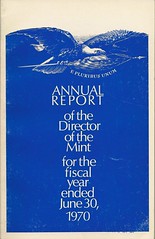
About UsThe Numismatic Bibliomania Society is a non-profit organization promoting numismatic literature. For more information please see our web site at coinbooks.org SubscriptionsThose wishing to become new E-Sylum subscribers (or wishing to Unsubscribe) can go to the following web page link MembershipThere is a membership application available on the web site Membership Application To join, print the application and return it with your check to the address printed on the application. Membership is only $15 to addresses in the U.S., $20 for First Class mail, and $25 elsewhere. For those without web access, write to: David M. Sundman, Secretary/TreasurerNumismatic Bibliomania
Society AsylumFor Asylum mailing address changes and other membership questions, contact David at this email address: dsundman@LittletonCoin.com SubmissionsTo submit items for publication in The E-Sylum, just Reply to this message, or write to the Editor at this address: whomren@coinlibrary.com
BUY THE BOOK BEFORE THE COINYou won't regret it! |
- WAYNE'S WORDS: THE E-SYLUM JULY 4, 2010
- PRESIDENT'S MESSAGE: ANA CONVENTION NBS ACTIVITIES
- NEW BOOK: 100 GREATEST U.S. ERROR COINS
- NEW BOOK: GOLD: EVERYTHING YOU NEED TO KNOW TO BUY AND SELL TODAY
- NEW BOOK: MODERN COMMEMORATIVE COINS BY ERIC JORDAN
- NEW BOOK: IMITATIONS IN CONTINUITY BY K.K. MAHESHWARI
- NEW BOOK: NUMISMATICS OF CENTRAL ASIA
- NEW BOOK: PAPER MONEY OF IRELAND
- BOOK REVIEW: STANDARD CATALOG OF U.S. ALTERED AND COUNTERFEIT COINS
- THE CYRUS DURAND ARCHIVE SCRAPBOOK
- HARVEY STACK ON THE CHASE MUSEUM, STACKS AND YOUNG NUMISMATISTS
- WWI MEDAL FOR "OUR COLORED HEROES"
- A VIRTUAL TOUR AND BRIEF HISTORY OF THE ANS LIBRARY
- MYSTERY NUMISMATIST OF 1885 REVEALED: D. W. VALENTINE
- TOIVO JOHNSON'S COIN DESIGNER MEDAL SERIES
- MORE ON THE ANNIE OAKLEY COIN
- ON THE TOTAL NUMBER OF DIFFERENT REGULARLY MINTED U.S. COINS
- MORE PUBLICATIONS OF THE COIN AND CURRENCY INSTITUTE
- MORE ON BASHLOW CONFEDERATE COIN RESTRIKES
- NOTES FROM E-SYLUM READERS: JULY 4, 2010
- QUERY: LORD'S SECURITY MINT IN INDIA
- ARTICLE PROFILES CRANE PAPER COMPANY
- INTERVIEWS WITH U.S. MINT PERSONNEL
- 1969-S DOUBLED DIE CENT DISCOVERY
- SPINK SELLS FIRST GOLD COIN STRUCK IN THE NAME OF AN ENGLISH KING
- CELEBRITY COIN COLLECTOR: DAVID SPADE
- FEATURED WEB PAGE: HISTORY OF COINS AND COIN PRODUCTION
WAYNE'S WORDS: THE E-SYLUM JULY 4, 2010

Among our new subscribers this week are David Amey, courtesy of John and Nancy Wilson, Mike Loar, Greg Meyer, and Dr. Jon P. Amato. Welcome aboard! We now have 1,359 subscribers.
Sorry for the lateness of this issue - last night there was a glitch at Binhost, the service we use to publish the newsletter. However, the delay allowed me to include NBS President Dan Hamelberg's message highlighting NBS activities at the upcoming ANA convention.
Next up are announcements of SIX new numismatic books and a review of an old but useful one. Other topics include Harvey Stack's reminiscences of the Chase Manhattan Money museum and visits from promising young numismatists, the "Our Colored Heroes" WWI medal, the Crane paper company and some great interviews with U.S. Mint personnel.
To learn about Asher B. Durand's brother, our mystery numismatist of 1885, Annie Oakley coins, Birmingham Mint machinery in India and how computers are getting TOO good at creating dies for U.S. coins, read on. Have a great week, everyone!
Wayne Homren
Numismatic Bibliomania Society
PRESIDENT'S MESSAGE: ANA CONVENTION NBS ACTIVITIES
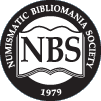 August is just around the corner! I hope all NBS members are marking the week of August 9 on their calendars. In addition to our NBS meetings there are meetings sponsored by just about every major numismatic group. Additionally, the week will be full of lectures and seminars for every numismatic taste. If early American history is of interest to you, Boston is the cradle of the revolution and offers an abundance of “living” U.S. history references along the Freedom Trail: so much to do, so little time!
August is just around the corner! I hope all NBS members are marking the week of August 9 on their calendars. In addition to our NBS meetings there are meetings sponsored by just about every major numismatic group. Additionally, the week will be full of lectures and seminars for every numismatic taste. If early American history is of interest to you, Boston is the cradle of the revolution and offers an abundance of “living” U.S. history references along the Freedom Trail: so much to do, so little time!
Our NBS schedule at the Boston ANA in August is set. The NBS Symposium will be held on Thursday, August 12 at 11:30 am to 1:00 pm). The symposium will feature John Adams with a presentation and discussion of his new book, Medallic Portraits of Admiral Vernon. In his review, Joel Orosz says “Medallic Portraits of Admiral Vernon does such a superb job of defining the previously indefinable, the only numismatic book in English to which it can appropriately be compared is Sylvester Sage Crosby's Early Coins of America.”
This “don't miss” presentation will be held in the Fairfax-A Room in the Sheraton Boston Hotel. Please note that the Sheraton Boston Hotel connects directly to the Convention Center and the Bourse Floor. The NBS Board meeting will immediately follow the symposium at 1:00 pm to 2:00 pm in the same room.
The regular NBS meeting will be held on Friday, August 13 at 11:30 am to 1:00 pm at the Massachusetts Historical Society. This is just a few blocks from the convention center. John Adams was instrumental in making the arrangements for us to have our regular meeting in one of the special library rooms in the MHS.
The regular meeting will include notes from the board meeting (previous day), current NBS status, literature dealer announcements, input from members, fund raiser auction (with Brad “open up your checkbook” Karoleff), future NBS projects, and a few surprises.
Our featured speaker will be Frank Campbell. Frank will highlight some of his favorite memories on books and personalities during his outstanding career as librarian of the ANS: another “don't miss” presentation. We will also be given an opportunity to look over some of the significant collections at the MHS, so plan for a little extra time. This should be a great meeting.
Donations. If you have any numismatic literature material that would be suitable for the NBS auction, please bring it to the regular meeting. The auction proceeds provide funds that allow us to continue our grants and awards. As you know, Brad will maximize the bidding on all the lots to maximize our treasury. Again this year we are providing a $1000 ANA summer seminar scholarship to some deserving Young Numismatist.
Be Sure to Vote. You will find a ballot in this issue of The Asylum to vote for the best overall article and the best new author for 2009. Please fill it out and return it by the due date. The award winners will be announced at the regular meeting in Boston. The Jack Collins Award for best new author carries a $250 prize. The NBS Writers Award for the best overall article recognizes the best author with a plaque.
Something new this year is the Young Numismatists' writing contest. We will award a $250 prize to the best article submitted by a YN. The YN articles will be reviewed by our editor and the winner will be published in a future edition of The Asylum.
ANA Exhibits. The Aaron Feldman Exhibit Award was funded some time ago and is handed out be the ANA for the best literature exhibit at the annual summer ANA. We need exhibits to trigger this award. Boston presents a fine opportunity to show some of your special items. See you in Boston!
—Dan Hamelberg
For more information about NBS, see our web site: www.coinbooks.org
Many educational opportunities await visitors. The Maynard Sundman/Littleton Coin Company Lecture Series, held Aug. 12, features original academic research; the topic this year is “New England Numismatics and Numismatists: Then and Now.” Presentations include “Colonial Edward H.R. Green, Collector Extraordinaire” by Peter Huntoon, “It May Prove a Drugg in Time: The Rise and Fall of Wampum in 17th Century Massachusetts” by Max B. Spiegel, “Making Money in Massachusetts” by Dr. Richard Doty and “Military Medals of the Colonial Wars” by Erik Goldstein.
Numismatic Theatre, held throughout the show, lets ANA members discuss their research and ideas in lecture format. Many talks focus on the convention's host region. This year's presentations include “Engraver and Patriot: Paul Revere, the Man and the Medallion” by convention medal artist Jamie Franki; and an early U. S. minting technology panel discussion with Dr. Richard Doty, Brad Karoleff, R.W. Julian and Douglas Mudd.
NEW BOOK: 100 GREATEST U.S. ERROR COINS
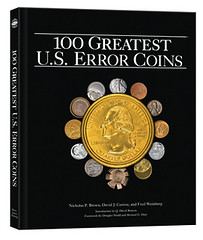 Whitman Publishing announces the release of 100 Greatest U.S. Error Coins, by Nicholas Brown, David Camire, and Fred Weinberg. The book will debut at the American Numismatic Association World's Fair of Money in Boston, August 11, 2010.
Whitman Publishing announces the release of 100 Greatest U.S. Error Coins, by Nicholas Brown, David Camire, and Fred Weinberg. The book will debut at the American Numismatic Association World's Fair of Money in Boston, August 11, 2010.
In this richly illustrated coffee-table book, three of America's best-known error-coin specialists take the reader on a personal guided tour of the remarkable misstrikes and other oddities produced by the U.S. Mint. 100 Greatest U.S. Error Coins is the seventh entry in Whitman Publishing's 100 Greatest™ library. It follows books that showcase coins, paper money, medals and tokens, comic books, and stamps.
“Each of the 100 Greatest error coins was voted into place by leading coin dealers, collectors, researchers, and historians,” said Whitman publisher Dennis Tucker. Inside, the reader will find prized and seldom-seen rarities—the unique and high-valued pieces that collectors dream about. The book also explores more readily available and widely popular error coins. All of them have a special “how'd that happen?” quality, and the authors explain how each error occurred.
Forewords by Richard Doty (senior curator of numismatics at the Smithsonian Institution) and Douglas Mudd (curator of the ANA's Edward C. Rochette Money Museum) welcome the reader to this fascinating part of the hobby. The introduction by Q. David Bowers includes a historical narrative on the U.S. Mint; numismatic aspects of error coins; and the history of error-coin collecting in the United States. “Errors have grown into one of the hobby's most active fields in recent years,” the authors note.
A two-page spread is devoted to each of coins No. 1 through No. 10, with Nos. 11 through 100 enjoying a full page. In the banner at the top of each page are the coin's rank, a descriptive title, and the quantity known. Essays describe the errors, how they were made, the circumstances of their discovery, and other interesting details. These essays are illustrated with enlarged photographs, and images of related errors. A summary of each coin's market value going back to 1980 is included.
The book is rounded out by an in-depth, heavily illustrated appendix on the minting process and how error coins are made and how they get out of the mint. This section's photographs include never-before-published images from inside the U.S. Mint's operations. A second appendix covers the famous “golden dollar mules” (with the obverse of a state quarter), including a detailed registry of the 10 specimens discovered so far.
“100 Greatest U.S. Error Coins is not just a value guide or a fancy picture book,” said Tucker. “It's a doorway that takes the reader to a hundred different points in the Mint's production processes, most of which have been kept secret for years. And it's a fascinating introduction to the hobby of collecting these important coins.”
Broadstrikes and brockages, off-centers and wrong planchets, die caps and double strikes and mules—all of these and more await the reader in 100 Greatest U.S. Error Coins.
The book is coffee-table-size, 144 pages, full color, with stories for every coin, and more than 500 illustrations. Retail price is $29.95. 100 Greatest U.S. Error Coins will debut in August 2010 at the ANA World's Fair of Money in Boston, and after that will be available online (including at WhitmanBooks.com) and at hobby shops and bookstores nationwide.
NEW BOOK: GOLD: EVERYTHING YOU NEED TO KNOW TO BUY AND SELL TODAY
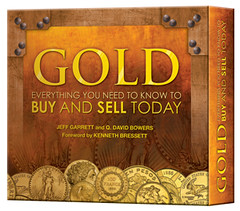 Take a personal guided tour with two of America's best-known gold specialists. Jeff Garrett and Q. David Bowers show you how to sell your gold without losing your shirt; how to make smart decisions when you buy gold; the best kinds of gold to invest in; traps and pitfalls to avoid; how to grade collectible gold coins; and much more. This interactive book includes handy pullouts with valuable insider information-take them with you when you buy or sell! Bullion value charts, coinage specifications, weight conversion tables, and much more. 120 Pages, Full Color, Hardcover, In Library-Quality Slipcase.
Take a personal guided tour with two of America's best-known gold specialists. Jeff Garrett and Q. David Bowers show you how to sell your gold without losing your shirt; how to make smart decisions when you buy gold; the best kinds of gold to invest in; traps and pitfalls to avoid; how to grade collectible gold coins; and much more. This interactive book includes handy pullouts with valuable insider information-take them with you when you buy or sell! Bullion value charts, coinage specifications, weight conversion tables, and much more. 120 Pages, Full Color, Hardcover, In Library-Quality Slipcase.
Michael E. Marotta provided this mini-review, with a promise of a more detailed look at the book later:
Whitman opens a new frontier with the presentation format of "Gold: Everything You Need to Know to Buy and Sell Today" by Jeff Garrett and Q. David Bowers (Foreword by Kenneth Bressett), 120 pages, $12.95. First of all, the page count is understated because the book includes ten pockets with tipped in ephemera, including (among very much else) a facsimile of Executive Order 6102.
The book is replete with charts, graphs, and tables of extracted data compiled for easy reference. Best of all, this is a book that is likely to decrease in value as the ephemera is damaged and lost. Therefore, anyone who holds a pristine copy in 100 years will be hoarding a mint.
For more information, or to order, see: Gold: Everything You Need to Know to Buy and Sell Today (www.whitmanbooks.com/Default.aspx?Page=81&ProductID=0794832067)
NEW BOOK: MODERN COMMEMORATIVE COINS BY ERIC JORDAN
 In recent years, the state quarter program and rise of Internet coin trading has created increased demand for modern commemorative coins. Author Eric Jordan describes the process by which collectors and investors can find correctly-priced coins of this nature in his new book, Modern Commemorative Coins, now available from Krause Publications.
In recent years, the state quarter program and rise of Internet coin trading has created increased demand for modern commemorative coins. Author Eric Jordan describes the process by which collectors and investors can find correctly-priced coins of this nature in his new book, Modern Commemorative Coins, now available from Krause Publications.
"Moderns are the fastest-growing segment of the coin market, and to date there has been a lack of resource materials aimed specifically at serving the interest and needs of this market," said KP Numismatics editorial director Debbie Bradley, a contributing editor on the book. "Modern Commemorative Coins arms collectors with the tools they need to predict future rarities, identify key dates for each type of modern, and price the coins in their collection."
Modern Commemorative Coins will show readers how to:
-Include modern coins in their self-directed IRA.
-Include numismatic investments as part of their estate plan.
-Select coins for purchase that have the best chance of increasing in value.
For more information visit www.shopnumismaster.com/product/modern-commemorative-coins/us-coins .
Author Eric Jordan began collecting coins at age 10, and worked as a coin grader for Palmetto Galleries in Columbia, S.C., while attending college. In the 1990s he changed his collecting focus to more affordable modern issues. To make correct buying choices he studied weekly sales figures from the U.S. Mint, eventually authoring a paper titled "The Case for Key Date Moderns," which has been downloaded more than 5,000 times at www.coinresource.com.
NEW BOOK: IMITATIONS IN CONTINUITY BY K.K. MAHESHWARI
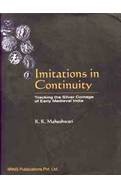 Contents:
Contents:
Introduction: Mapping the journey of Indo-Sasanian coinage.
1. In search of beginnings: i. The Sasanian originators. ii. Enter the Huans. iii. Firuz's coins: replications and implications.
2. Enter: two great early medieval currencies: i. Currency in flux: from the mints of the Marauders. ii. Invaders Indianised: the spread of the Gurjara-Pratiharas. iii. Drammas and Gadhaiyas: sorting out variants.
3. Tracking the evolution of the Gadhaiya: i. More about the Gadhaiya branch of the Indo-Sasanian family. ii. Gadhaiya Type I. iii. Gadhaiya Type II. iv. Inscribed Gadhaiyas. v. Malwa Gadhaiyas.
4. The Dawn of Eastern Indo-Sasanian currency: the Chahamanas: i. The Vasudeva imitations. ii. Sri Ha coins. iii. Derivatives of Sri Ha.
5. Eastern Indo-Sasanian currency reaches its Zenith: the pratiharas: i. The Monetisation of the imperial Pratihara empire. ii. Sri Ma coins. iii. Vigrahapala Drammas. iv. Srimadadivaraha drammas. v. Vinayakpala drammas.
6. Contemporary references. Wrap up: Sifting the basket of Indo-Sasanian currencies.
Author(s) : K.K. Maheshwari
Format : Hardcover
ISBN-13 : 9788186786284
Pages : 320p., 153 Figures; Bibliography; Index
Pub. Date : 01 Jan 2010 , 1st ed.
Publisher : IIRNS Publications
Language(s) : English
To order, see: Imitations in Continuity: Tracking the Silver Coinage of Early Medieval India (www.bagchee.com/en/books/view/59988)
NEW BOOK: NUMISMATICS OF CENTRAL ASIA
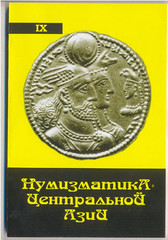
For more information (in Russian), see:
NEW! Numismatics of the Central Asia # 9 2010
(cgi.ebay.com/ws/eBayISAPI.dll?ViewItem&item=280524822030)
NEW BOOK: PAPER MONEY OF IRELAND
The definitive guide to Irish banknotes from the
origins of banking in Ireland to the present day
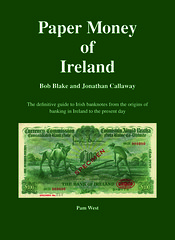 First Edition Published 2009 © Bob Blake and Jonathan Callaway
First Edition Published 2009 © Bob Blake and Jonathan Callaway
Authors: Bob Blake and Jonathan Callaway
Publisher: Pam West
ISBN: 978-0-9543457-2-3
This book took well over 10 years' research by the authors to complete. It is by far the most comprehensive book on Irish banknotes covering all of Ireland and detailing every note issued by every bank since the 17th century. The book contains a vast amount of historical background information as well as exhaustive details of the notes themselves.
An easy to follow cataloguing system enables the amateur/specialist to seek information on any specific Bank/banknote.
The book contains 500 pages with over 750 full colour illustrations. Realistic valuations throughout.
The book also covers related areas such as the early Tradesman issues, Prisoner of War issues, Republican bonds and other items broadly falling under the definition of paper numismatics.
For future editions the publisher and authors ask readers to submit details of new discoveries.
Sadly, Bob Blake passed away in January 2009 and did not live to see the project's final completion. He is hugely missed.
PRICE: £40
Available from: Pam West, PO Box 257 Sutton Surrey SM3 9WW.
Tel:020 8641 3224
www.britishnotes.co.uk
Email:
pamwestbritnotes@aol.com
Here is a review by Roger Outing:
Just reading the contents page of this superb catalogue will lift the spirits of any knowledgeable banknote collectors. The catalogue contains full details of the banknote issues of Bank of Ireland since 1783; Belfast Banking Co 1827 – 1968; National Bank of Ireland 1835 – 1964; Northern Banking Co since 1825; Provincial Bank of Ireland 1825 to 1981; Allied Irish Banks 1982 – 1993; First Trust Bank since 1994; Ulster Banking Co since 1836; the ‘Lady Lavery' series issued by The Currency Commission and then the Central Bank of Ireland 1928 – 1977, Central Bank of Ireland 1976 to 2001 and the iconic ‘Ploughman' series from 1929 to 1941.
This represents a lot of banknotes and a great deal of marvelous detail for the collector and it is all as close to definitive as anyone might reasonably expect.
If this catalogue only contained the above mentioned details then you would feel obliged to describe it as being very good indeed. However, it contains much more. Also listed are the Private Bankers 1700 -1836; Tradesmen & Sundry Issuers since 1750 and miscellaneous Joint Stock Banks 1825 – 1839.
These sections represent the catalogue's significant and innovative contribution to Irish banknote collecting in particular and Irish banking history in general. This information, which lists all the relevant banks and their known issues, is not readily available from any other single source. For example, the Irish private banks exceed 200 in number and their private issues of banknotes have never before been so comprehensively listed and described.
This is a treasure trove of new information for the banknote collector and researcher. Mention is also given to such disperate elements as Irish Republican Bonds, early cheques, skit notes, lottery tickets, circular notes and travellers' cheques.
The catalogue entries are clearly and precisely laid out with each note fully described with details of signatures, dates and prefix + serial number ranges when appropriate. Pricing estimates are given for each note in a range of conditions that are appropriate to the age of each separate issue. Colour Trial, Proof, Specimen and Replacement notes are included whenever these are known.
The 600+ full colour illustrations are excellent and the early and rarely seen notes, especially, are a joy to behold. With all this information any collector should be able to readily identify, catalogue and value their Irish banknotes.
Irish paper money is a complex topic and this catalogue, quite correctly, makes no attempt to simplify. Instead it does a wonderful job of providing the essential detailed information, in an easy to follow format, that the collector needs in order to fully comprehend the full range of material that is available. This is a great banknote catalogue and an essential buy for anyone with an interest in Irish paper money.
To read about my conversation with Pam West, see: WAYNE'S LONDON DIARY 8 SEPTEMBER, 2007: JURY'S COIN FAIR (www.coinbooks.org/esylum_v10n36a12.html)
BOOK REVIEW: STANDARD CATALOG OF U.S. ALTERED AND COUNTERFEIT COINS
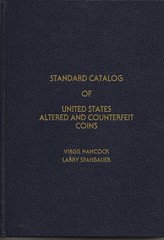 Like most variety collectors, I have almost every book I know about on small cents, and many on buffalo five centers, and I usually try to get the most recent figuring the older published books are outdated. But when this book I am currently reading was mentioned in a prior thread, I found one from one of Amazon's resellers, and it was inexpensive and new. It is Hancock's and Spanbauer's Standard Catalog of United States Altered and Counterfeit Coins (1979) 220 pages.
Like most variety collectors, I have almost every book I know about on small cents, and many on buffalo five centers, and I usually try to get the most recent figuring the older published books are outdated. But when this book I am currently reading was mentioned in a prior thread, I found one from one of Amazon's resellers, and it was inexpensive and new. It is Hancock's and Spanbauer's Standard Catalog of United States Altered and Counterfeit Coins (1979) 220 pages.
It doesn't have the high definition photos of most newer books (most are line drawing types), but it covers a wider range of deceitful coins and their origins. It also provides much info on practices before I began to really collect this area. I don't want to cover too much, but I found the table of weights and specific gravities of coins very useful. Quite a bit about modern and ancient castings, and modern EDM ( electrical discharge manufacturing ) making of dies. The photo of the 1955/55 DDO fake that the maker had the 2nd strike in the wrong direction or Henning's 1944 Jeffersons where the P was left off.
I didn't know that in 1968 one dealer sold 95,000 fake 1909-SVDB coins that could pass eye inspection. Anyway, it is an enjoyable read, I can pass over the part where ANA and ANAC are mentioned as the only safe way to check your coin as PCGS, NGC, etc. were not yet players as I recall.
If you don't find a way to buy it, ask your college or county library if they participate in Interlibrary loan where they can borrow it from another library for you to read.
Given the recent rash of new counterfeit coins it's high time a publisher comes out with an expended version of this book or a new one similar to it. Of course now, some of these fakes (like the Wyatt, Robinson, Idler, Bolen and Dickeson copies of U.S. colonial coins) actually have some value in the market and could be priced in the book. Is anyone working on such a book project? -Editor
To read the complete article, see: Sometimes the old reference books are still informative. (www.cointalk.com/t116106/)
THE BOOK BAZARRE
THE CYRUS DURAND ARCHIVE SCRAPBOOK
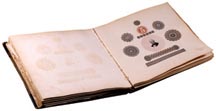 Featured within The 52 Collection is a special section of amazing and unique plates from an archive scrapbook originally put together by inventor Cyrus Durand, brother of famous American painter Asher B. Durand. The plates are composed of India paper proof elements affixed to pages in fascinating arrays to display the technology and artistry of the Durand patents alongside the work he did with several companies he was with from the 1830s until his death in 1868. The 96 different plates feature advertising pieces, intricate large cyclodials, smaller counter and die proofs, and full color proof banknotes.
Featured within The 52 Collection is a special section of amazing and unique plates from an archive scrapbook originally put together by inventor Cyrus Durand, brother of famous American painter Asher B. Durand. The plates are composed of India paper proof elements affixed to pages in fascinating arrays to display the technology and artistry of the Durand patents alongside the work he did with several companies he was with from the 1830s until his death in 1868. The 96 different plates feature advertising pieces, intricate large cyclodials, smaller counter and die proofs, and full color proof banknotes.
Historically, Cyrus Durand is barely known. He was a member of an important family and his brother Asher Brown Durand was an iconic member of the esteemed Hudson River School of American painters. Asher Durand worked with his brother as an engraver for several years. Many of those 1820s Asher Durand signed engravings are featured in this auction. Eventually, for his mindset, it made much more sense for him to become one of the great American painters of the period and not toil away as an engraver.
In John Durand's The Life and Times of A. B. Durand (1894, Charles Scribner's & Sons, New York), Cyrus gets little mention and is lightly researched. Unfortunately, this seems to be the fate of many engineers who did not create inventions that changed the world or made men richer, like a Franklin, Fulton, Morse, or Edison for example.
When first encountered, the archive book was mostly disbound, without a spine, and with the covers separated, though the internal page contents were actually quite fine. It started as an empty square stock scrapbook with pages (and covers) 260mm by 260mm (10.25 by 10.25 inches) with integral tissue guards between each of the pages.
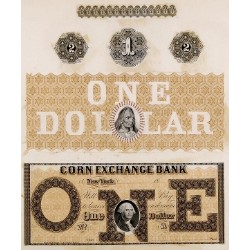 The book was likely put together during the 1855-1860 period, at minimum under the supervision of Cyrus Durand, if not physically by him. Each plate consists of affixed India paper elements, anywhere from one to many, formed into “mini-sample” sheets.
The book was likely put together during the 1855-1860 period, at minimum under the supervision of Cyrus Durand, if not physically by him. Each plate consists of affixed India paper elements, anywhere from one to many, formed into “mini-sample” sheets.
The book is roughly chronological in imprint style with early lathe work and two early C. Durand advertising pieces in the front. Towards the early middle and center of the book are the majority of the Danforth, Wright & Co. imprinted and associated elements including color proof essay notes. The book closes out with lathe panels and radiating color backs.
Many questions are answered through the contents of these plates and their relationship with many superb obsolete banknotes from the late 1850s. However, this subject matter is so broad in scope that the contents published and offered here will hopefully create future dialogue and advanced research on this subject.
The mysterious white haired gentleman, once concealed within the pages of this security printing primer of great historical importance and beauty, has finally emerged into the light. Each plate within this book is a unique item and a record of the immense genius and mechanical artistry of Cyrus Durand, who hopefully will no longer be obscured by the shadow of his famous brother.
To view the complete online catalog description, see: The Cyrus Durand Archive Plates from the 52 Collection (www.stacks.com/Auction/Collection/82)
HARVEY STACK ON THE CHASE MUSEUM, STACKS AND YOUNG NUMISMATISTS
 I read with great interest the story of the Chase Money Museum that Richard Margolis wrote in the June 27th issue of The E-Sylum.
I read with great interest the story of the Chase Money Museum that Richard Margolis wrote in the June 27th issue of The E-Sylum.
It brought back some great memories. I remember my early years in Stack's, from as early as 1947 to the early 1960's, the great sources of Numismatics the city of New York offered anyone who had an interest in collecting coins.
The Chase Money Museum was located on 6th Avenue (now the Avenue of the Americas) and 50th Street. It was developed under the great leadership of Vernon Brown. As with most places of interest it was open 6 days a week and visitors from all over came to this midtown location. One of the nearby attractions was its neighbor, Radio City Music Hall.
The displays at the museum changed regularly, and were designed to show the history of Money, mostly of the United States, but it also had interesting displays of foreign, ancient and world currency. It showed the relationship of coins and currency to trade and growth in the world. It even had a great exhibit of Odd and Curious Currency.
Vernon Brown often gave lectures on the weekends to visitors to instill an interest in coins and to encourage collecting.
The reason this museum is part of my memories, was the location of Stack's during the l940's and early years of the 1950's, Stack's was housed in a store and offices of West 46th Street, near 6th Avenue, just a short walk from the Chase Museum. One of the great coin clubs that visited the area was from the Pingry School of New Jersey, a prep-school for talented young men. Among the extra-curricular activities the school offered its students was a Coin Club.
One of the proctors was Edward Knoke, who taught History and Economics, sometimes using coins as a teaching aid. Coins fascinated these young students, and they met each Saturday as a club to discuss numismatics, and also had a "show and tell". About once a month they made a field trip to New York and visited the Chase Money Museum, as it offered many different coins for them to see and learn from. They usually arrived on a Saturday morning and stayed for a few hours. Then Edward Knoke would take them around to coin shops in the area so they could see more coins and possibly acquire some for their collection.
One of the first places they visited was Stack's on 46th Street. My father, Morton, My Uncle Joe, and the three junior Stacks, me, Ben and Norman always welcomed these fine young gentlemen. Stacks was somewhat unique in New York - it had a street level shop, sit-down counters and a Hall of Cabinets, which housed coins from all part of the world, from ancient to modern times.
The knowledge these boys had about coins was astounding, and therefore they were invited to view the displays, study coins in the cabinets, ask questions, use the Stack working library and just exchange ideas.
We realized that these were to be some of the great numismatists of the future so we at Stack's encouraged them and gave them the time and freedom they needed to pursue their hobby. Many of these young men eventually in the next decades became the collectors whose collections were noteworthy. It must be remembered that they were encouraged by Edward Knoke and Vernon Brown to go out past them and learn more about collecting. We all learned from each other.
These field trips did include several visits to dealers around us, such as Wayte Raymond, Charles Worsmer, Hans Schulman and others, but they were only comfortable in the spacious facilities that Stack's offered, as the others were in offices and didn't provide the space for several dozen young people to browse about. So Stack's for them became a "Club House". I might add, that many mature collectors who worked in New York found the "club house" atmosphere quite inviting for them to gather also.
Stack's always welcomed young numismatists to its premises. I can remember numismatists who can be counted as welcomed guests included such greats as Cornelius Vermuele, John J. Ford, Jr., Walter Breen, Q. David Bowers and of course Richard Margolis, to mention but a few.
I guess you can see why I said earlier, the nostalgia that the Richard Margolis story possessed revived one the many memories I have of working in Numismatics, and stayed actively engaged for over 62 years.
To read the earlier E-Sylum article, see: RICHARD MARGOLIS ON THE CHASE MANHATTAN MONEY MUSEUM (www.coinbooks.org/esylum_v13n26a16.html)
WWI MEDAL FOR "OUR COLORED HEROES"
Mark Broyard writes:
Many years ago before my father died he gave me a medal he said belonged to his father who was a "colored" soldier stationed at camp Lejeune in Mississippi during World War One. The medal is identical to the one referred to in your article of 2007 entitled "Mystery Medal For "Our Colored Heroes".
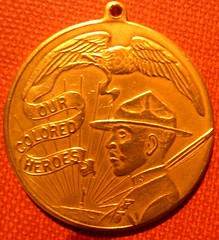
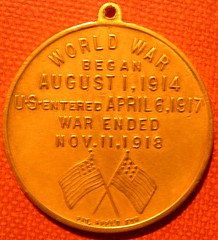
The medal is stamped "Our Colored Heroes" with an eagle on top, a portrait of a soldier below it with the inscription on a ribbon-like banner on the left side and a rising/setting sun at the bottom. The back of the medal is the same with the words "World War Began August 1, 1914, US Entered April 6, 1917, War Ended Nov 11, 1918" with two flags crossed and the words "U.S Patent Appl'd For" at the very bottom.
According to my father (Emile Joseph Broyard, Jr. of New Orleans, Louisiana), it was given to his father, Emile Joseph Broyard, Sr. (also of New Orleans) when he returned from the service after the war ended.
My father told me his father told him that the medal was presented to him by the "colored" chapter of the veterans of foreign wars (VFW). Apparently the white soldiers were honored with a parade after the war ended, but the south being as segregated as it was before, during and after the war, the city of New Orleans neglected to honor their African-American soldiers, as they were not allowed to fight and their work was limited to menial and for the most part hard labor tasks and their contributions were deemed less than worthy of honor. These medals were struck and presented to the soldiers.
I have no proof as to the validity of this story but my father was an avid coin collector with a small collection and whenever he would bring out his coins when I was a child and on into adulthood this was the story he told about this medal. It's a fascinating, logical story and one worthy of validation. Perhaps some research is in order.
To read the earlier E-Sylum article, see: MYSTERY MEDAL FOR "OUR COLORED HEROES" (www.coinbooks.org/esylum_v10n13a22.html)
A VIRTUAL TOUR AND BRIEF HISTORY OF THE ANS LIBRARY
The July 2nd issue of the ANS eNews from the American Numismatic Society announced:
You can now take a virtual tour and explore the history of the Harry W. Bass, Jr. Library online. To begin the tour, visit http://www.numismatics.org/Library/VirtualTour

The library lounge. The library of the ANS maintains non-circulating collections. Much of the Library material is arranged on open stacks so that visitors can browse freely. In addition to library materials, the collection also contains the ANS institutional archives and personal papers and collections of significant numismatists and numismatic organizations.
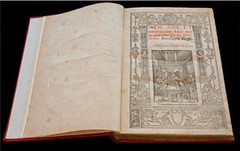 The entrance to the library takes the visitor past the rare book room, which houses important rare materials and the archives in climate controlled conditions. Small exhibits of books are sometimes on display.
The entrance to the library takes the visitor past the rare book room, which houses important rare materials and the archives in climate controlled conditions. Small exhibits of books are sometimes on display.
The rare book room of the ANS library contains many treasures, such as this copy of De asse et partibus eius, by Guillaume Budé, from 1516. It is a pioneering study of Roman coinage, weights and measures, and is considered to be one of the earliest books devoted to the study of ancient coins.
To take the complete tour, see: The ANS Library: A Virtual Tour and Brief History (www.numismatics.org/Library/VirtualTour)
MYSTERY NUMISMATIST OF 1885 REVEALED: D. W. VALENTINE
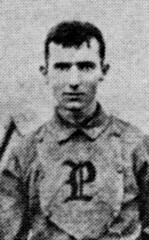
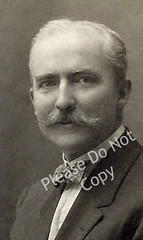
Our winner is Pete Smith, who wrote:
Where do the interests of Jerry Fochtman and Benny Bolin intersect? The answer I come up with is... Daniel W. Valentine.
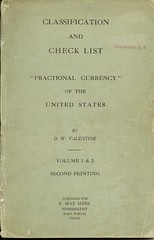
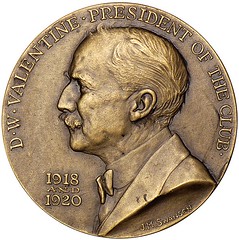
Above is my copy of the second printing of Valentine's 1924 work on Fractional Currency. Jerry provided the above image of Valentine's New York Numismatic Club President's medal, and Pete provided the following entry on Valentine from his American Numismatic Biographies book. Thanks, gentlemen!
Valentine, Daniel Webster Author (b. 3/7/1863 d. 1/24/1932)
Born in New York City. Received D.D.S. from the New York College of Dentistry in 1887. Married to Ada Belle Colwell. They had two daughters. Practiced as a dentist in New York City 1887 to 1896. He moved to Englewood, New Jersey, and lived there from 1896 until his death.
He exhibited half dimes at the ANS in 1914. Author of Fractional Currency of the United States in 1924. The cloth bound edition of 225 copies cost $5.00 each. Twenty-five numbered copies bound in full leather were sold at $15.00 each. Author of The United States Half Dimes in 1931, originally published by ANS as monograph 48, reprinted in 1975.
Served as president of the New York Numismatic Club for two terms in 1918 and 1920. He was honored with one of their presidential medals. Design was by J. M. Swanson. There were eight silver and 50 bronze medals struck. He died at home in Englewood, New Jersey.
obit: NUM 45 Mar 1932 page 178 bio: NUM 64 Mar 1951 page 269
By the way, the latest version of Pete's book is still available on the NBS web site, and your input is needed. Are you listed? If so, please review your entry for accuracy and completeness. Are there any mistakes or important omissions? You can access the book here: American Numismatic Biographies (www.coinbooks.org/resources/anb_2010.pdf).
Jerry adds:
The inside back cover of John Adams' book American Numismatic Literature (Volume I: 19th Century Auction Catalogs) has a picture taken at the November 7, 1916 S.H. Chapman sale of the Lyman collection. Valentine is one of the bidders seated in the picture.
To read the earlier E-Sylum article, see: MORE ON THE MYSTERY NUMISMATIST OF 1885 (www.coinbooks.org/esylum_v13n25a10.html)
THE BOOK BAZARRE
TOIVO JOHNSON'S COIN DESIGNER MEDAL SERIES
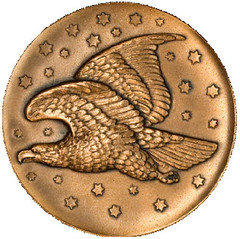
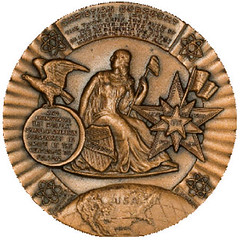
Len Augsburger had an interesting article in the E-Gobrecht that arrived this week. Incidentally that is an interesting internet monthly newsletter on Liberty Seated coins and their American artist-creator, Christian Gobrecht. Editor Bill Bugert does a great job.
Len had purchased a Gobrecht item on eBay, a lead trial strike of the reverse of a medal in honor of Gobrecht, and revealed the seller was the son of the "medal designer." There's a lot more to the story however.
The issuer was a Maine numismatist, Toivo Johnson (1913-1973) and no relation to the present writer. In 1961 he developed the idea to issue a series of medals to honor coin engravers. His idea was to reproduce the artist's most popular design on one side and a tribute to the artist on the other.
He first approached William Louth, president of Medallic Art Company. He came to New York and told Bill of his plan. He wanted Medallic Art to strike the medals. Bill liked the idea of honoring coin designers, but not reproducing the coin design. This was still the era when exact coin images were verboten -- illegal -- and he rejected that concept.
He suggested to Toivo to have the artist's portrait on one side and the other a tribute to the artists' numismatic creations. He could have a top artist create the models. Toivo was firm in his mind, that was not what he wanted. The two exchanged words. Toivo left with the rejection ringing in his ears. He would show that Bill Louth what he wanted. So he went to Medallic Art's competitor, Metal Arts in Rochester, New York.
Here they would do whatever Toivo wanted, and would change each coin design slightly to get around the illegality of reproducing an exact coin design. The designs were not modeled but machine engraved where dies are cut by a tracer controlled pantograph operated by a factory artist. That "artist" was Robert Stephen Schabel (1909-1995).
Tracer controlled engraving starts with an oversize drawing, an outline of the design. The machine operator rides a stylus across that outline, following each line while a rotating cutting tool cuts that line into the surface of the die. Then he goes back and by hand and eye determines how deep the relief should be for each element of the design. The goal is to create the cavities of relief in a die -- in negative -- to strike the medal.
Such engraving does not allow for error or experimentation. It cuts a die at one time and that's it! This in contrast to a "modeled" design in which the artist works in clay and can experiment, changing and improving a relief element as many times until satisfied with the final result, or go back and start all over. In the struck piece a tracer-controlled design is somewhat flat and lifeless. On the other hand a modeled design is more realistic, lifelike. More artistic effort is usually put into a modeled design.
To his credit, Schabel's designs were exceptional, perhaps the best of his career. He produced the dies for six medals for Toivo's Coin Designer Medal Series. In addition to the Gobrecht medal that Len mentions in is article, the series honored Victor David Brenner, Charles Barber and Augustus Saint-Gaudens issued in 1962, plus ancient coin engraver Evanetos, James B. Longacre, and that Christian Gobrecht issued in 1963.
Years later Toivo Johnson went back to Metal Arts company and had two more medals made, here again with dies cut by Schabel, the American Freedom Medal and the Maine Sesquicentennial Medal. Both of these were issued in 1970.
Len mentioned that the seller told him the Gobrecht medal "is the most popular in the series because of the space theme" (of an eagle in flight); that "apparently there are a lot of space collectors out there pursuing different kinds of space-related memorabilia."
That is an example of nonnumismatic nonsense! If we examine the number of medals sold at auction the Saint-Gaudens medal was four times more popular than the Gobrecht. Only the Longacre medal has fewer auction appearances than the Gobrecht, with the Brenner the second most popular.
When I was a medal dealer, I received a call one day from the son of Toivo Johnson after the father's death. He still had on hand a quantity unsold of the Coin Designer Medals twenty-five years after they were first issued. I didn't buy them from him.
But the thought crossed my mind: What if Toivo had listened to Bill Louth and issued more artistic, modeled medals for that series. Would they have sold out?
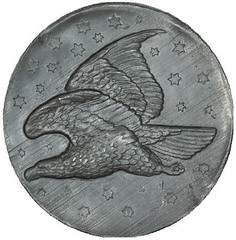
Lead Trial Strike
To read the complete E-Gobrecht issue, see: The E-Gobrecht July 2010 (Whole # 66) (www.seateddimevarieties.com/66-E-GobrechtVolume6,Issue7.pdf)
MORE ON THE ANNIE OAKLEY COIN
Regarding the 1853 French 5 Centimes coin purportedly shot thru by famed sharpshooter Annie Oakley, Philip Mernick writes:
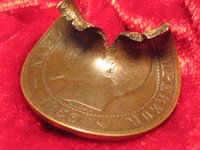 So many French (and to a lesser extent Italian) 5 and 10 cents were imported into England to pass as half and one penny coins that their import was prohibited by the Customs Amendment Act of 1886. This means that when Annie Oakley came to London with the Buffalo Bill show in 1887 the logical coin to shoot at would have been one of these now unloved "coppers". They may also have taken a quantity back to the USA. The French 5 cent was bigger than the current US cent and would have made a better target (presumably 2 cent coins would have been hard to find by then).
So many French (and to a lesser extent Italian) 5 and 10 cents were imported into England to pass as half and one penny coins that their import was prohibited by the Customs Amendment Act of 1886. This means that when Annie Oakley came to London with the Buffalo Bill show in 1887 the logical coin to shoot at would have been one of these now unloved "coppers". They may also have taken a quantity back to the USA. The French 5 cent was bigger than the current US cent and would have made a better target (presumably 2 cent coins would have been hard to find by then).
Tom DeLorey concurs. He writes:
Regarding the alleged Annie Oakley 5 Centimes, there is a plausible explanation for it being used by her as a target: the face value of the coin at the time was approximately one cent U.S. money, but it is a broad, thin coin that would provide a much bigger target than a U.S. Cent of the same value.
Also, because foreign base metal coins had no value in this country, the troupe may have been able to acquire quantities of such coins, or similar base metal foreign coins, at a mere fraction of a cent from bullion dealers who bought foreign coins but did not want to bother attempting to redeem the base metal ones in their countries of origin. The audience, seeing a coin shot out of the air, would not care where it was from.
Now, another question: Where did the bullets come down?
To read the earlier E-Sylum article, see: RERUN: HISTORY DETECTIVES TACKLE PURPORTED ANNIE OAKLEY COIN (www.coinbooks.org/esylum_v13n26a12.html)
ON THE TOTAL NUMBER OF DIFFERENT REGULARLY MINTED U.S. COINS
Last week Duane Feisel asked:
Does anyone have a count of the total number of different United States coins regularly minted? This would include all denominations, designs, dates, mint marks, compositions and the like, but would exclude patterns, trials, proofs and the like. Perhaps someone already has this information before I sit down with a Red Book and start counting.
Those old Mint reports have the information. The 1970 report covers from 1793 to 1970 by mint, denomination, etc. There may be some later ones as well, but nothing in this century (they stopped putting in older data a long time ago).
To read the earlier E-Sylum article, see:
QUERY: TOTAL NUMBER OF DIFFERENT REGULARLY MINTED U.S. COINS
(http://www.coinbooks.org/esylum_v13n26a14.html)
MORE PUBLICATIONS OF THE COIN AND CURRENCY INSTITUTE
David Ganz writes:
The Coin & Currency Institute have been clients of my firm since the mid-1970's. Arthur & Ira Friedberg are the current principals. In addition to the books that you mention, C&C also published (and Arthur edited) Current Coins of the World 1850-1964 and Current World Coins (the subsequent period book) in the early 1980's. (I was part of that joint venture).
That edition was translated and sold in Japan as well. Sales were brisk but Arthur concluded (correctly, I think) that it was simply too much work for a one or two person band.
Mike Paradis writes:
I think there is at least one more publication by Coin & Currency Institute, Inc.: Complete Catalog of United States Large Size Star Notes 1910-1929
To read the earlier E-Sylum article, see: PUBLICATIONS OF THE COIN AND CURRENCY INSTITUTE (www.coinbooks.org/esylum_v13n26a10.html)
MORE ON BASHLOW CONFEDERATE COIN RESTRIKES
Larry Gaye writes:
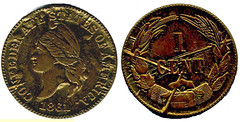 The world is indeed a strange place where serendipity abounds. I read the David Gladfelter submission regarding the Confederate States of American/Bashlow et. al. restrikes after having had lunch with a regular group of coin geeks. One of the aforementioned pulled from his pocket a PCGS slabbed Continental Dollar issued by Mr. Bashlow in 1962. I remember the ads for these in various numismatic publications at the time of issue. An interesting conversation ensued, which of course let to the Scott CSA restrikes. Fun stuff!
The world is indeed a strange place where serendipity abounds. I read the David Gladfelter submission regarding the Confederate States of American/Bashlow et. al. restrikes after having had lunch with a regular group of coin geeks. One of the aforementioned pulled from his pocket a PCGS slabbed Continental Dollar issued by Mr. Bashlow in 1962. I remember the ads for these in various numismatic publications at the time of issue. An interesting conversation ensued, which of course let to the Scott CSA restrikes. Fun stuff!
George Corell writes:
My thanks to David Gladfelter for his contribution to the information pool on Bashlow and his sets. Having someone with the original papers that go with the set is important. I would love to have a scan of that paperwork to add to my library.
That paperwork seems to confirm that the sets were pre-release promo's to the individual pieces and intended to be a limited offering. Given Bashlow's penchant for marketing it fits that he would seek to offer to the market something to which scarcity would attach.
Thousands of individual coins but merely a relative few "official" sets. The exact number contemplated or released seems to remain a mystery. Perhaps we will never know for sure how many "sets" were originally sold. In today's market the sets remain at least scarce if not rare.
Bashlow had a mindset towards exactness and originality to the original device, though not the original coins. Bashlow's "second restrikes" were not to the original Lovett cent but rather to Haseltine's restrikes.
Haseltine differentiated his restrikes from Lovett's original by alloy and die alignment. Bashlow differentiated his from both Lovett and Haseltine. Differentiating from Lovett by alloy, die alignment and thickness, whereas from Haseltine by alloy and planchet thickness in coin alignment.
Bashlow, unlike Lovett and Haseltine, did not have the luxury to employ the original dies due to their degraded state. However, transfer dies made from the original Lovett dies fit the model for exactness and became his hallmark or signature.
Jonathan Brecher is quoted as saying that Tom Jankovsky is one of the current authorities in the context of the six coin Bashlow set yet there is no reference to what Mr. Jankovsky has said or contributed to our knowledge of the sets. I am intrigued by this reference since the only known association Mr. Jankovsky has to the Bashlow phenomenon is his advocacy of the single thickness gold Bashlow like piece, a coin of which little is known and is of unknown origins.
What is known of this coin is that it was not struck from the dies August Frank made for Bashlow using the transfer process from Lovett's original dies. From Bashlow's known associates and contemporaries we know that Bashlow had absolutely nothing to do with these pieces. Those of us who have studied Bashlow and his work have concluded the he would be both embarrassed and possibly insulted to have his name attached to a coin that is inexact and somewhat crudely struck. Hence, it is a Bashlow "like" piece, but certainly not a Bashlow original "second restrike".
Wayne, keep up the good work here as we all gain by the open forum debates in The E-Sylum.
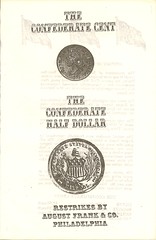
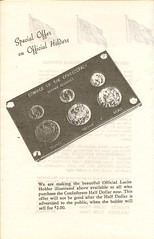
To read the earlier E-Sylum article, see: MORE BASHLOW CONFEDERATE COIN RESTRIKE SIX-COIN SETS (www.coinbooks.org/esylum_v13n26a15.html)
NOTES FROM E-SYLUM READERS: JULY 4, 2010
In my review of Astronomical Symbols on Ancient and Medieval Coins by Marshall Faintich, I wrote:
A solar eclipse in 585AD was reported to have "stopped the war between the Lydians and the Medes.
Leon Saryan writes:
I don't think Lydians and Medes had anything to do with each other in AD times!! If I have to I can dig out information to support the supposition that this must have been BC.
Arthur Shippee caught this, too. He writes:
It's BCE, of course. Look at who are involved.
Regarding those strange "good luck" symbols on tokens, Martin Purdy writes:
 I'm skeptical that these have anything to do with runes. I have some familiarity with the runic alphabet, and its letters don't look anything like the elements featuring on these tokens.
I'm skeptical that these have anything to do with runes. I have some familiarity with the runic alphabet, and its letters don't look anything like the elements featuring on these tokens.
We might go further with the "hieroglyphs" theory. I've had a quick look through some sources here and found the attached (from "Reading the Past, Ancient Writing from Cuneiform to the Alphabet", British Museum 1990, p. 109).

Allowing for a bit of straightening out of curves for whatever reason (style, or simply a copy of a copy of a copy, perhaps), I think this may be what the symbol on the "good luck" token is meant to represent. Some may not see any similarity, but if Chinese characters can "morph" into the simplified phonetic syllables used in Japan (hiragana and katakana) over a period of thousands of years, then the little bit of adjustment needed to make this theory fit isn't excessive!
As always, I'm happy to be proved wrong if anything more plausible turns up.
To read the previous E-Sylum article, see: SO WHAT IS THIS STRANGE 'GOOD LUCK' SYMBOL? (www.coinbooks.org/esylum_v13n26a18.html)
Regarding policy changes for exhibitors at the upcoming Boston ANA convention, Alan V. Weinberg writes:
Sadly, I will not be exhibiting this year at the Boston ANA or any future years even though I've exhibited significantly (ie 1792-93 rarities) at the summer ANA for the past 5-6 years.
The new ill-conceived policy of no early bird badges for exhibitors is the deciding factor. Once you set up your exhibit, you're out - you must leave the bourse floor and wait 'til the public enters the next day.
I know a number of other prospective exhibitors feel the same way and were astonished to hear this. I was going to exhibit my superb Massachusetts silver coinage in Boston . Now, I'll reserve my exhibiting for the January FUN shows where they know how to appreciate exhibitors.
There sure is a major chasm between the FUN and Whitman Expos' early bird policy and the ANA's new absolutely NO early birds policy.
Dick Johnson writes:
Dick Hanscom replied in last week's E-Sylum to my comment in the previous week's issue. I chided Dick for the troubles he had encountered trying to strike medals from a die he had engraved himself. I called his activities a "home minting kit."
He responded in great good humor, although he stated he was not laughing out loud. No LoL.
Further he asks if I would be at the Boston ANA convention, he would like to chat with me. The answer is YES. I will be at the Signature Art Medals bourse, booth # 1230 on the center isle across from the escalators. I will be there all five days.
We have only four medals for sale. So we have invited Medallic Art Company to join our location and make it more educational than commercial. We plan an exceptional display of how these four medals are made. This includes (1) die-struck, (2) foundry cast, (3) electrogalvanic cast, and (4) hand engraved. Each of these four techniques are shown with a distinctive Abraham Lincoln medal made by each technique.
Even if you have been in numismatics for over seventy years, like I have, you can learn something from this display. You can actually handle the dies and each one of the medals to observe how they differ. How a cast medal differs from a die struck medal or from a galvano. You can learn the benefits and diagnostics of each. And, perhaps, if one of our Lincoln medals turns you on, you can purchase it on the spot.
But please plan to stop by one day of the show. I would love to chat with anyone on numismatic technology -- how coins and medals are made -- even if one of our Lincoln medals doesn't "talk" to you.
Come see me at booth # 1 - 2 - 3 - 0. Let's chat.
QUERY: LORD'S SECURITY MINT IN INDIA
P.K. Saha posted this query to the Coins mailing list (coins@uni.edu):
Can any one enlighten me about minting of Bangladesh coins by a private mint in India?
Equipment from the Soho Mint can be found in Lord's Security Mint Limited in Renigunta (near Tirupati), I'm told by Sudhir Ravindran, an advocate in Madras. It was established as the largest coin blanking facility in India, he adds.
Lord's Mint was set up in 2003 as a joint venture between the Andhra Pradesh Government and a family group led by P. Ravindran, the father of my correspondent. Its equipment came from a Spanish mint popularly known by its anagrammed name, LOCSA. To complement this machinery, more was bought from the Birmingham Mint that had taken over the Soho Mint.
The Birmingham Mint, set up by Ralph Heaton, was at its peak when it was producing millions of one and two denomination Euro coins for the European Union, on a subcontract from the Royal Mint, but when the contract was not renewed and business slumped, the Birmingham Mint was put on sale in 2003 and was picked up by J.F.T. Law & Co, which produces commemorative coins and medals.
Law's put up for sale the machinery it did not need — particularly the Soho Mint machinery that the Birmingham Mint had acquired — and the principals of Lord's in Madras acquired a substantial part of this equipment. The first order the Lord's Mint executed was for coins for Bangladesh, minting them (after trials) on a subcontract from the Indonesian Government Mint on whom the order had been placed by the Bangladesh Central Bank.
Unfortunately, shortly after this, P. Ravindran, on his way from Madras to Renigunta, was badly injured in a serious road accident and is still bed-ridden. With that, the Mint's activities have ground to a halt, but attempts are at present being made to revive it.
To read the complete article, see: Madras Miscellany: From Birmingham to Renigunta (www.thehindu.com/arts/history-and-culture/article488968.ece)
THE BOOK BAZARRE
ARTICLE PROFILES CRANE PAPER COMPANY
![]() Giant, rumbling machines fill the factory, the sound of turning gears echoing off walls as they press, stretch, and spool sheaths of paper into what look like 4-foot-wide rolls of toilet tissue. But this paper will be used for redesigned $100 bills the Federal Reserve plans to issue in February — the next step in its constant quest to thwart counterfeiters.
Giant, rumbling machines fill the factory, the sound of turning gears echoing off walls as they press, stretch, and spool sheaths of paper into what look like 4-foot-wide rolls of toilet tissue. But this paper will be used for redesigned $100 bills the Federal Reserve plans to issue in February — the next step in its constant quest to thwart counterfeiters.
Crane & Co., known better for its pricey stationery, runs the plant in a secluded swatch of the Berkshires. It is the only spot in the United States where the paper that winds up in wallets, purses, and cash registers is made, and Crane has been the sole maker of US currency paper — everything from $1 to $100 notes — for more than 130 years.
Counterfeiting has been a problem even longer, cropping up soon after the United States started printing its national currency. Today, the challenge has grown as cheap copiers and scanners make it easier to start small-scale counterfeit operations anywhere in the world, said Max Milien, a spokesman for the Secret Service.
“Economic times are hard, unfortunately,'' he said. “People are willing to try anything.''
The most advanced and costly technology in the new $100 bill is a three-dimensional security ribbon — manufactured by Crane in an undisclosed location outside Massachusetts — which is woven into the paper next to Benjamin Franklin's portrait.
The blue strip, less than half an inch wide, contains more than a million, microscopic lenses on the surface. Each lens acts like a tiny projector, magnifying the ink images printed underneath. Together, the lenses produce two sets of images — bells and the number 100 — that move around and morph into one another as the paper is tilted.
Shifting images make it harder for counterfeiters to create forgeries, and the moving bells and 100s are easy-to-spot, easy-to-explain features anyone can check just by bending the bill back and forth.
The other new security measure is an image of a bell inside a copper inkwell, also on the front of the note. As the bill is moved, the bell changes color, blending in with the inkwell when it turns copper and reappearing when it turns green.
By September, Crane must produce enough paper for 2.4 billion revamped $100 notes. (At any given moment, 6.5 billion of the bills are circulating, most of them abroad.)
To read the complete article, see:
Mass. firm adds razzle-dazzle to cash
(www.boston.com/business/technology/articles/2010/06/28/
crane_puts_some_razzle_dazzle_in_the_currency_to_thwart_counterfeiters/)
We invite you to visit The Crane Museum of Papermaking, housed in Crane's 1844 Old Stone Mill. The museum, first opened in the autumn of 1930, is on the National Register of Historic Places. The one-story building is pleasantly situated on the banks of the Housatonic River, which supplied the water to wash the rags and drive the machinery of the early Crane mills.
With its rough-hewn oak beams, colonial chandeliers, many-paned windows and wide oak floorboards, the interior resembles the Old Ship Church in Hingham, Mass. In this appropriate setting, you will find a scale model (made by Dard Hunter) of the vat house of the first Crane mill, as well as some of the hand molds that Zenas Crane used from 1801 to 1831. In wall and floor cases, exhibits trace the history of American papermaking from Revolutionary times, with special emphasis on the durable, distinctive Crane papers made for currency, bonds, stock certificates and elegant stationery.
The museum is open Monday through Friday from 1 to 5 p.m., free of charge, from early June through mid-October.
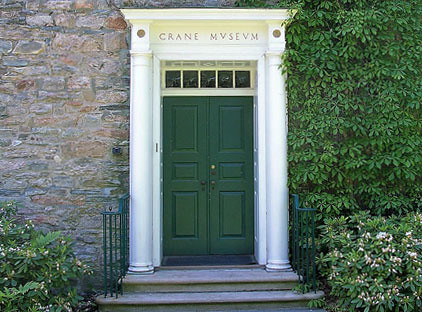
INTERVIEWS WITH U.S. MINT PERSONNEL
I went to the United States mint in Philadelphia to meet some of the faces who create the money we all spend every day.
I also found out how our national coin-making process has moved into the 21st century. As strange as it seems, a few years ago, one Mint employee's chance viewing of the Shrek DVD with his grandchildren ended up transforming the way our money is designed and delivered to us.
On the day of my visit, the Mint was producing the new Yosemite quarter, the third in its new America the Beautiful series of 56 twenty-five cent pieces. Five designs will appear each year until 2021. Joseph Menna, one of the senior sculptor-engravers, is responsible for the back side of the Yosemite quarter, which will be released to the public on July 25.
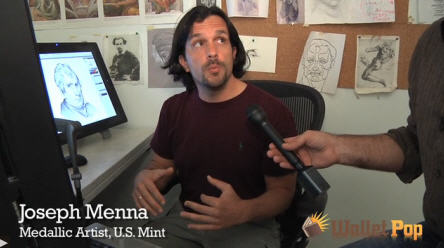
All of the Mint's designers started out as gifted sculptors who are classically trained. Menna studied in Russia and is expert in handling bronze. In fact, as a mark of esteem, every engraver gets to add his or her initials to the money you use every day. Have a close look at the change in your pocket, and you'll find the signed handiwork of some of the only classically trained sculptors given a steady public forum in America today.
But these masters don't work in clay much anymore; many of them now translate their skills to the virtual realm with specialized software called FreeForm, used by Hollywood and surgeons alike. Each software license costs as much as a down payment on a new house.
Menna explains how the old art of coin-making has moved into modern times, yet has never abandoned the practical, classical training that has been demanded of sculptors for centuries. He also talks about the gratification that comes with being the creative mind behind what's jangling in your pocket right now.
To read the complete article, see:
Exclusive! The artists at the U.S. Mint who engrave our coins digitally now
(www.walletpop.com/blog/2010/06/28/exclusive-the-
artists-at-the-u-s-mint-artists-who-engrave-our/)
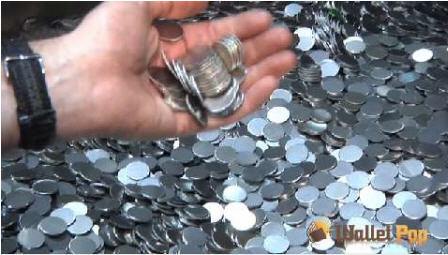
There is also a nice video tour of the coin production floor. View it here:
Video exclusive! Watch the U.S. Mint make new Yosemite quarter
(www.walletpop.com/blog/2010/06/30/video-exclusive
-watch-the-u-s-mint-make-new-yosemite-quarter/)
Chief Engraver John Mercanti has seen and done it all. From the days of mixing plaster to create molds to sculpting with a computer, Mercanti has been a part of the design evolution, and a strong advocate of new technology.
“In the old days, we would model the image and then I would actually make lines where the type was going to go, and I would go into a negative plaster and cut lettering by hand,” Mercanti said. “It could take longer to do the lettering than the artwork.”
In fact, the accounting department once asked how long it took the engravers to make a letter. “We said 15 minutes,” Mercanti said. And remember, there are lots of letters on U.S. coins.
“We used to hand punch the mintmark on every single die,” said Mercanti. “The Mint shop would bring 200 to 300 dies in and before we did any of the day's work, we had to take a punch and hammer and make the mintmark.”
It was not a precise science.
“We called them walking mintmarks because they'd be all over the place,” Mercanti said. Although there was a specific area the mintmark was meant to be placed, because it was done by hand, no two dies were identical.
“The hardest denomination was the nickel, because (the mintmark) was out in space,” Mercanti said.
But all that has changed with computer technology.
“It would take up to three to five days to get one satisfactory die,” Mercanti said. “Now we have a good die on the first try 99 percent of the time.”
But with new technology comes new challenges.
On an easel in the corner of the third-floor conference room at the Philadelphia Mint, are the following words:
“What's causing cracking?”
“Blanks?”
“Heat treat?”
“Collar?”
“Tonnage”
The engravers had met earlier with the production staff to determine why cracking was occurring on some coins.
It looked like technology got just a little too good.
Janvier machines generated soft curves, Mercanti said. With computerized sculpting, distinctive lines can be made, and those hard edges may result in stress marks that cause cracking, he said. The answer? Go in and soften the lines created on the computer.
“Sharp corners cause stress marks and under high stress, dies crack,” Mercanti said. “So what we have to do now is go back to the data and insert round corners and soften edges.
“If we don't, we have die cracking, and that's unacceptable because we are judged on die life.”
To read the complete article, see: Mint Engravers Embrace 21st Century Technology (www.numismaster.com/ta/numis/Article.jsp?ad=article&ArticleId=11905)
1969-S DOUBLED DIE CENT DISCOVERY
 First there was one, then three and now there are four 1969-S Doubled Die Obverse No. 1 cents that have been found by collectors within just the past three years.
First there was one, then three and now there are four 1969-S Doubled Die Obverse No. 1 cents that have been found by collectors within just the past three years.
Such a find is financially rewarding. One of them sold for $126,500.
The valuable variety shows strong hub doubling on the date, LIBERTY and IN GOD WE TRUST.
In a telephone interview with the finder of the latest specimen, I learned that he had found it in a roll of 1969-S cents that he had put together from tens of thousands of cents that he had pulled from $25 bank boxes of predominantly circulated cents from 1998 through 2005.
On March 29, 2010, he found this 1969-S doubled die; the fourth coin down in the first of approximately 20 rolls of the date that he still hadn't taken back to the bank. He said he immediately knew there was something wrong with the coin because the date and mottoes on the obverse seemed fuzzy. A closer look with a glass revealed that it was indeed the doubled die.
Later, when error-variety coin specialist Charles Clark was advised by fellow collector, Tony Zupkas, that Brian was claiming to have found a 1969-S doubled die cent, he was skeptical since most reports of this nature turn out to be strike doubling. Strike doubling is a form of doubling that occurs within a split second after the strike and/or at the time the coin is being ejected from the press and adds no value to a coin. A true doubled die coin is one that struck with a die that is itself doubled – made that way during the hubbing process.
In this case of the 1969-S doubled die obverse No. 1, we have what is referred to as a Class 1 Rotated Hub doubled die. This class of doubling occurs when there is a rotational misalignment between images.
As can be seen in the images shown here, the final overlying image is rotated counterclockwise in relation to the earlier underlying image. The direction of spread on hub doubling is defined as the direction you must move from the underlying images to the usually stronger overlying image. Thus, this variety is defined as a Class 1 Rotated Hub with counterclockwise doubling.
To read the complete article, see: $100,000 find (numismaticnews.net/article/100000_find/)
SPINK SELLS FIRST GOLD COIN STRUCK IN THE NAME OF AN ENGLISH KING
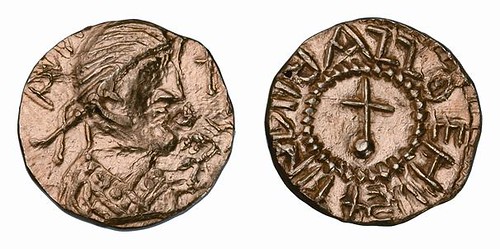
Spink is very pleased to announce the sale of an Anglo-Saxon gold Shilling of King Eadbald of Kent dating from c.620-635. This is the first gold coin struck in the name of an English King and a rare and important piece of English history. Found near Deal Kent in 2010, this coin will be sold at auction on June 24th and is expected to fetch upwards of £8,000.
This type of coin was long known to be amongst the earliest of Anglo-Saxon gold coins with a single example present in the important Crondall hoard found in Hampshire in 1828 which was hidden c.670. However, the conclusive attribution of these coins to King Eadbald of Kent, who reigned from 616 to 640, was only made in 1998.
On the obverse “avdvarld reges” is written and is translated as 'of King Audvarld'. The name 'auduarldus' appears in Bede's Historia Ecclesiastica completed in 731 in which he wrote about king Eadbald of Kent. The reverse inscription is a corruption of the word londenv indicating London as the mint or die source for this coin.
The real significance of these coins though is in the obverse inscription which names the historical figure of king Eadbald. This is exceptional for a coin of this period and is only certainly found again at the end of the seventh century with the silver coins of Aldfrith of Northumbria (685-705). As such the Eadbald gold Shilling is the earliest coin issued in the name of an English king.
Only six coins of this type are recorded. Of these, five are kept in institutional collections. Therefore, this will be only the second specimen available for private collectors to purchase.
To visit the Spink web site, see: www.spink.com
CELEBRITY COIN COLLECTOR: DAVID SPADE
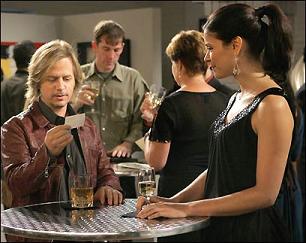 Before he hit it big with Saturday Night Live and scored hits with Tommy Boy and Black Sheep, David Spade was a coin collector, a hobby which didn't make him popular with the ladies. Spade, who co-stars with his SNL buddy in the box-office hit Grown-Ups, recalls other hobbies which also ensured that much of his childhood was a girl-free zone.
Before he hit it big with Saturday Night Live and scored hits with Tommy Boy and Black Sheep, David Spade was a coin collector, a hobby which didn't make him popular with the ladies. Spade, who co-stars with his SNL buddy in the box-office hit Grown-Ups, recalls other hobbies which also ensured that much of his childhood was a girl-free zone.
"I didn't know I was a nerd until I thought my uncirculated 1916-D Mercury Dime would be a panty-dropper, and it turned out not to be."
To read the complete article, see: DAVID SPADE: COIN COLLECTOR!! (http://www.hollywoodoutbreak.com/2010/06/28/david-spade-coin-collector/)
FEATURED WEB PAGE: HISTORY OF COINS AND COIN PRODUCTION
This week's Featured Web Page is Grunal Moneta's "A Brief History of Coins and Coin Production"

The earliest accredited coins were made in the 7th century BC in Lydia (congruent with Turkey's modern provinces of Izmir and Manisa). These were small blobs of electrum, (a naturally occurring alloy of gold and silver), and were decorated on one side only with the forepart of a bull, a lion or both; later a secondary design was added to the reverse. These images were impressed on the alloy by using a simple punch hit with a hammer.
livinghistory.co.uk/homepages/grunalmoneta/
history.html

